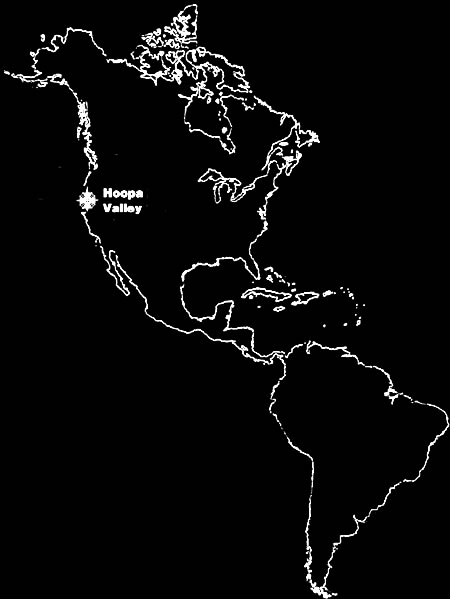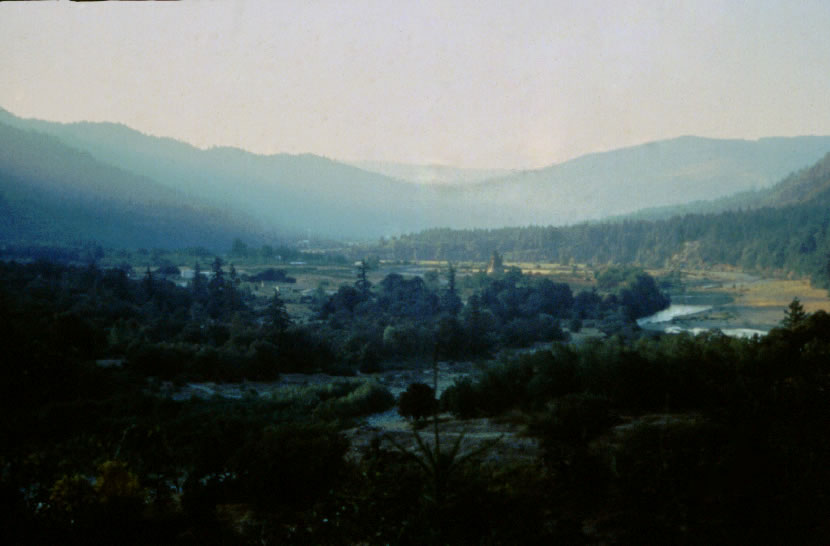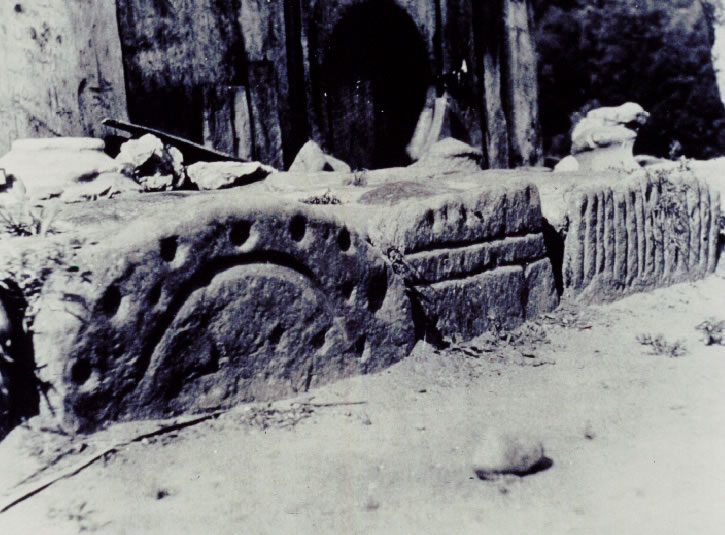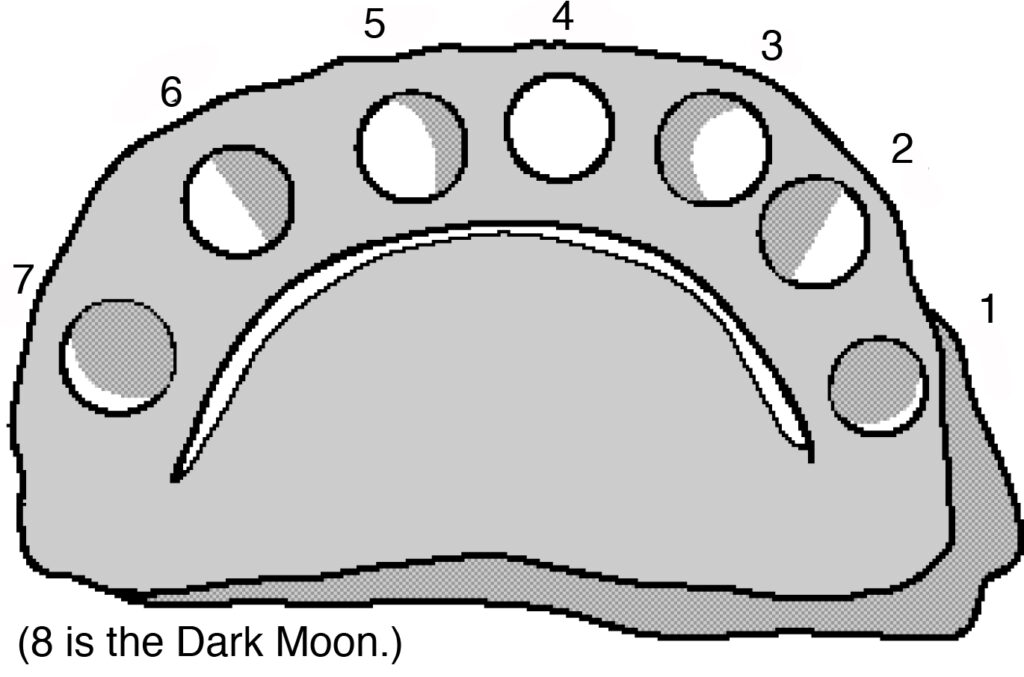The Hupa People:Who Live Where The Trails Lead Home
DIGITAL EFFECT: Hupa People Crossfade scene to the coordinates of Hoopa Valley (41.06434°N 123.68271°W), on 2012/11/16 approximately 90 minutes after sunset. Scale up the Sun and Moon 5x for easier viewing of lunar phases and solar alignments. The date was specifically chosen as a November date with a waxing crescent Moon. If users wish to keep the year current, dates will have to be revised to match the appropriate lunar phase.
VISUAL 3 (still): Map of Northern California with Hoopa Valley Marked

Let’s first visit Hoopa Valley in Northern California. This is the home of the Hupa people who call themselves Na Tin Ukxwe (na-din-o-hwe), which means “people who live where the trails lead home.”
VISUAL 4 (still): Hoopa Valley from Ridge Top
Fade on a small image of the view of the Hoopa Valley at the marked position on the map, and then scale up and move the image off to the side for viewing.

The Hupa people live along the Trinity River. To keep their lives attuned to the natural world and to know the seasons of fishing, hunting, and harvesting, the Hupa developed a precise calendar system based on the Sun, Moon, and stars.
Crossfade the map and Hoopa Valley images with the image of the Hupa Calendar Stones.
VISUAL 5 (still): Sacred House with Calendar Stones

These stones were the public calendar of the Hupa people before contact with Europeans. The stones, about 18 inches high, are sacred objects left by the immortals for the people.
The photograph of these Calendar Stones was taken early this century. They are the Moon Stone, the Universe Stone, and the Year Stone.
[Point out, left to right.]
The stone on the right is the Year Stone. The stone in the center is the Universe Stone, which shows the Hupa idea of the universe. The top band is the sky, the center band is the Earth, and the bottom band is the underworld.
The stone on the left is called the Moon Stone. In 1970, a tragedy occurred. The Moon Stone was stolen and has not been recovered! If you discover where the Moon Stone is, please let us know and we will report it to the Hupa so they can get back their sacred stone. I’ll show you how the Moon Stone is used to keep a calendar.
DIGITAL EFFECT: Moon Phases Turn the planetarium clock on, and fade on the cardinal directions, in preparation for observing Moon phases through time. Moon at waxing crescent.
Look at the Moon in the planetarium sky. What do you call the Moon in this phase?
[Invite students to stand up to look for the Moon if they are sitting directly beneath it.
Take responses until someone says crescent.]
That’s right, we call this the crescent Moon. The Hupa people call it the New Moon, because it is the first time they see the Moon after it has been gone for a few days. Its appearance begins the lunar month as it does for many people worldwide.
Please take a clipboard and clip the handout in place so that you can see the drawing of the three stones.
Have students get clipboards. Hand out Calendar Stone drawing, and have students look at them.
VISUAL 5 (still): Calendar Stones

Let’s look at the Moon Stone again. There are 7 shallow holes across the top of the stone that are used to track the Moon as it changes. When the First Moon appears, as we see in the sky now, the Hupa mark the first shallow hole on the right side of the stone. Point to it.We think they used a natural paint to mark the stone, and washed it off at the end of a complete cycle.
On your drawing, please draw the Moon in the first circle by darkening in the part you cannot see.
You can use the outline of the circle as the outline for the Moon. You will have just a thin white crescent left.
Each hole on the Moon Stone is used to mark the appearance of the Moon about every 3 to 4 days. Let’s use the planetarium as a time machine to look at the Moon for each position on the Moon Stone. We are looking at the Moon just after sunset each day.
Young children enjoy counting off the days out loud.
At each position, ask “Do you know what we call this Moon phase today?” and students can draw the Moon’s shape on their Calendar Stone drawing.
Phases on the Stone:
1st circle—waxing crescent
2nd circle—first quarter
3rd circle—waxing gibbous
4th circle—full
DIGITAL EFFECT: 3 Days to 1st Quarter
Fade off the Moon and run time three days into the future to the first quarter Moon. If possible, as time advances allow the sky to “flash” at a rate of 1 day/second to give the appearance of time passing. At the end of the advance, fade the Moon back on.
DIGITAL EFFECT: 4 Days to Waxing Gibbous
In a manner similar to “DIGITAL EFFECT: 3 Days to 1st Quarter” above, advance time 4 days into the future to view a waxing gibbous Moon.
DIGITAL EFFECT: 4 Days to Full
In a manner similar to “DIGITAL EFFECT: 3 Days to 1st Quarter” above, advance time 4 days into the future to view a full Moon.
For each phase, ask:
Do you know what we call this Moon phase today?
Please draw the Moon in the next circle. The full Moon is just rising at sunset.
At the full Moon ask:
Where will the Moon be 3-4 days from now?
[It will be below the eastern horizon—not visible at sunset.]
After the full Moon, it cannot be seen in the evening; it can only be seen after midnight.
We will watch the Moon cross the sky as it does in just one evening, and we will observe the remainder of the Moon phases every 3-4 days at sunrise instead of sunset.
Note: The phrase first quarter can be confusing. Many people say it looks like a half Moon. The term quarter can refer to the fact that you can see a quarter of the entire surface of the spherical Moon. Alternatively, quarter can refer to the fact that the moon has gone through one quarter of its monthly cycle.
Turn on music.
DIGITAL EFFECT: Go to Predawn
Run diurnal motion forward over the course of a single night to approximately 1 hour before sunrise the next day, with full Moon in west, in preparation for viewing the waning phases.
While the Moon crosses the sky, you can mention that the Hupa also keep a private calendar at home. It is a set of Moon markers, which are moved one each day from one basket to another to keep track of the Moon. This is useful in bad weather as well.
Give students time to draw in the remaining circles at each phase.
5th circle—waning gibbous
6th circle—third (last) quarter
7th circle—waning gibbous
8th (no circle)—new (dark) Moon
DIGITAL EFFECT: 4 Days to Waning Gibbous
Show the remaining Moon phases very quickly. Run sidereal motion at at rate of 4 days in 4 seconds to show the Full Moon shrinking to a waning gibbous Moon. The “sky” and Moon remain visible as time passes. Note: Use the actual date of the gibbous Moon.
DIGITAL EFFECT: 4 Days to Last Quarter
In a manner similar to “DIGITAL EFFECT: 4 Days to Waning Gibbous” above, run sidereal time forward to view a third quarter Moon.
DIGITAL EFFECT: 4 Days to Waning Crescent
In a manner similar to “DIGITAL EFFECT: 4 Days to Waning Gibbous” above, run sidereal time forward to view a waning crescent Moon.
After the waning crescent phase, ask:
What will the Moon look like 3-4 days from now?
[It gets dark.]
The Hupa people call it the Dark Moon and say that it is shining underground in the land of the dead. The whole lunar cycle that you have just observed is about 29-1/2 days long, including the Dark Moon, about one month. The Hupa word for a lunar month is mining (min-ning) which literally means “its face,” and begins when Crescent Moon reappears at sunset. You can see the Moon in the sky during about 28 days of the whole cycle. The Moon’s cycle of changes makes a natural calendar that everyone can see.
VISUAL 5 (still): Calendar Stones
Now, we can understand the Year Stone.

[Point to it on the image.]
Each time a new lunar cycle begins, one bar on the Year Stone is marked.
There are 13 bars on the Year Stone, but how many months does your calendar have? [Only 12.]
And, how many days long are those months?
[Some are 30, some are 31 days.]
All the days of all the months in your calendar add up to 365 days, which is the length of a year. The first twelve Hupa months are each 29-1/2 days. This adds up to only 354 days, 11 days short of the yearly Sun cycle, which is 365 days. Rather than making every month longer than a true lunar cycle, the Hupa have a thirteenth month which is about 11 days long. The 13th month is called by the Hupa the “bad luck, spoiled Moon” month.
Optional
To save time, you can go through the last half of the lunar cycle very quickly. Students need not draw the remaining phases. Students can be invited to keep their Moon Stone handouts and draw in the remaining holes when they watch the cycles of the Moon in the real sky.

